CCNA 2 Chapter 6 V6.0 Answers
1. Which type of VLAN is used to designate which traffic is untagged when crossing a trunk port?
default
native
management
data
2. What are three primary benefits of using VLANs? (Choose three.)
end user satisfaction
a reduction in the number of trunk links
security
improved IT staff efficiency
cost reduction
no required configuration
3. When configuring a router as part of a router-on-a-stick inter-VLAN routing topology, where should the IP address be assigned?
to the VLAN
to the interface
to the subinterface
to the SVI
4. Refer to the exhibit. PC-A and PC-B are both in VLAN 60. PC-A is unable to communicate with PC-B. What is the problem?

The VLAN that is used by PC-A is not in the list of allowed VLANs on the trunk.
The trunk has been configured with the switchport nonegotiate command.
The native VLAN should be VLAN 60.
The native VLAN is being pruned from the link.
5. Open the PT Activity. Perform the tasks in the activity instructions and then answer the question.
Which PCs will receive the broadcast sent by PC-C?

PC-D, PC-E
PC-A, PC-B, PC-D, PC-E
PC-A, PC-B
PC-A, PC-B, PC-D, PC-E, PC-F
PC-A, PC-B, PC-E
6. Refer to the exhibit. DLS1 is connected to another switch, DLS2, via a trunk link. A host that is connected to DLS1 is not able to communicate to a host that is connected to DLS2, even though they are both in VLAN 99. Which command should be added to Fa0/1 on DLS1 to correct the problem?
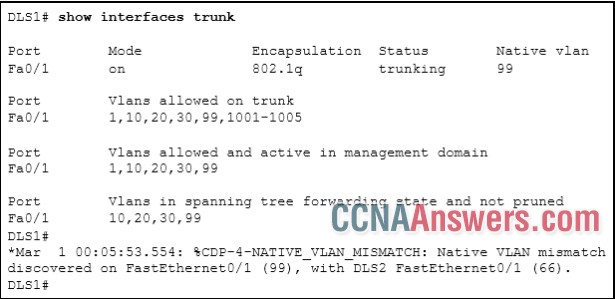
switchport mode dynamic auto
switchport trunk native vlan 66
switchport trunk allowed vlan add 99
switchport nonegotiate
7. What happens to a port that is associated with VLAN 10 when the administrator deletes VLAN 10 from the switch?
The port becomes inactive.
The port goes back to the default VLAN.
The port creates the VLAN again.
The port automatically associates itself with the native VLAN.
8. What must the network administrator do to remove Fast Ethernet port fa0/1 from VLAN 2 and assign it to VLAN 3?
Enter the no vlan 2 and the vlan 3 commands in global configuration mode.
Enter the no shutdown command in interface configuration mode to return it to the default configuration and then configure the port for VLAN 3.
Enter the switchport access vlan 3 command in interface configuration mode.
Enter the switchport trunk native vlan 3 command in interface configuration mode.
9. A network administrator is determining the best placement of VLAN trunk links. Which two types of point-to-point connections utilize VLAN trunking? (Choose two.)
between two switches that share a common VLAN
between a switch and a client PC
between two switches that utilize multiple VLANs
between a switch and a network printer
between a switch and a server that has an 802.1Q NIC
10. Which command is used to remove only VLAN 20 from a switch?
no vlan 20
no switchport access vlan 20
delete vlan.dat
delete flash:vlan.dat
11. When a Cisco switch receives untagged frames on a 802.1Q trunk port, which VLAN ID is the traffic switched to by default?
Unused VLAN ID
data VLAN ID
management VLAN ID
native VLAN ID
12. Match the IEEE 802.1Q standard VLAN tag field with the descriptions. (Not all options are used.)
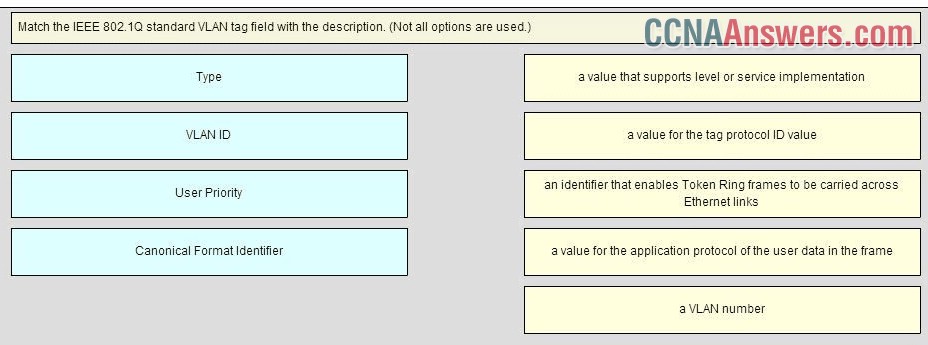
Place the options in the following order:
a value that supports level or service implementation => User Priority
a value for the tag protocol ID value => Type
an identifier that enables Token Ring frames to be carried across Ethernet Links => Canonical Format Identifier
a VLAN number => VLAN ID
13. Which four steps are needed to configure a voice VLAN on a switch port? (Choose four)
Configure the switch port interface with subinterfaces.
Activate spanning-tree PortFast on the interface.
Configure the switch port in access mode.
Add a voice VLAN.
Ensure that voice traffic is trusted and tagged with a CoS priority value
Assign the voice VLAN to the switch port.
Assign a data VLAN to the switch port.
Configure the interface as an IEEE 802.1Q trunk.
14. Refer to the exhibit. A network administrator needs to configure router-on-a-stick for the networks that are shown. How many subinterfaces will have to be created on the router if each VLAN that is shown is to be routed and each VLAN has its own subinterface?
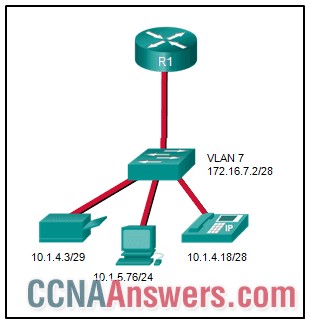
2
3
5
4
1
15. Which two characteristics match extended range VLANs? (Choose two.)
VLANs are initialized from flash memory.
VLAN IDs exist between 1006 to 4094.
They are commonly used in small networks.
They are saved in the running-config file by default.
CDP can be used to learn and store these VLANs.
16. A small college uses VLAN 10 for the classroom network and VLAN 20 for the office network. What is needed to enable communication between these two VLANs while using legacy inter-VLAN routing?
A switch with a port that is configured as trunk is needed to connect to a router.
A router with one VLAN interface is needed to connect to the SVI on a switch.
A router with at least two LAN interfaces should be used.
Two groups of switches are needed, each with ports that are configured for one VLAN.
17. Refer to the exhibit. In what switch mode should port G0/1 be assigned if Cisco best practices are being used?
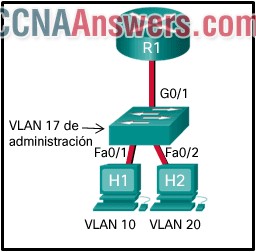
access
native
auto
trunk
18. What is a characteristic of legacy inter-VLAN routing?
The router requires one Ethernet link for each VLAN.
The user VLAN must be the same ID number as the management VLAN.
Only one VLAN can be used in the topology.
Inter-VLAN routing must be performed on a switch instead of a router.
19. Fill in the blank. Use the full command syntax.
The show vlan command displays the VLAN assignment for all ports as well as the existing VLANs on the switch.
20. A high school uses VLAN15 for the laboratory network and VLAN30 for the faculty network. What is required to enable communication between these two VLANs while using the router-on-a-stick approach?
Two groups of switches are needed, each with ports that are configured for one VLAN.
A multilayer switch is needed.
A router with at least two LAN interfaces is needed.
A switch with a port that is configured as a trunk is needed when connecting to the router.
21. A Cisco switch currently allows traffic tagged with VLANs 10 and 20 across trunk port Fa0/5. What is the effect of issuing a switchport trunk allowed vlan 30 command on Fa0/5?
It allows only VLAN 30 on Fa0/5.
It allows VLANs 1 to 30 on Fa0/5.
It allows a native VLAN of 30 to be implemented on Fa0/5.
It allows VLANs 10, 20, and 30 on Fa0/5.
22. What is a disadvantage of using router-on-a-stick inter-VLAN routing?
does not scale well beyond 50 VLANs
does not support VLAN-tagged packets
requires the use of more physical interfaces than legacy inter-VLAN routing
requires the use of multiple router interfaces configured to operate as access links
23. Port Fa0/11 on a switch is assigned to VLAN 30. If the command no switchport access vlan 30 is entered on the Fa0/11 interface, what will happen?
VLAN 30 will be deleted.
An error message would be displayed.
Port Fa0/11 will be returned to VLAN 1.
Port Fa0/11 will be shutdown.
24. Refer to the exhibit. Router RA receives a packet with a source address of 192.168.1.35 and a destination address of 192.168.1.85. What will the router do with this packet?

The router will forward the packet out interface FastEthernet 0/1.2.
The router will drop the packet.
The router will forward the packet out interface FastEthernet 0/1.2 and interface FastEthernet 0/1.3.
The router will forward the packet out interface FastEthernet 0/1.3.
The router will forward the packet out interface FastEthernet 0/1.1.
25. Refer to the exhibit. A router-on-a-stick configuration was implemented for VLANs 15, 30, and 45, according to the show running-config command output. PCs on VLAN 45 that are using the 172.16.45.0 /24 network are having trouble connecting to PCs on VLAN 30 in the 172.16.30.0 /24 network. Which error is most likely causing this problem?
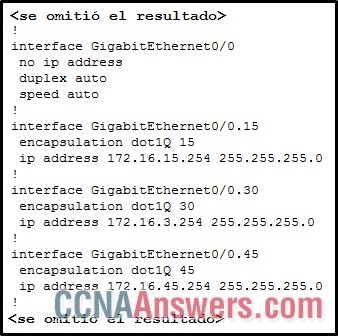
There is an incorrect IP address configured on GigabitEthernet 0/0.30.
The GigabitEthernet 0/0 interface is missing an IP address.
The wrong VLAN has been configured on GigabitEthernet 0/0.45.
The command no shutdown is missing on GigabitEthernet 0/0.30.


Leave a Reply